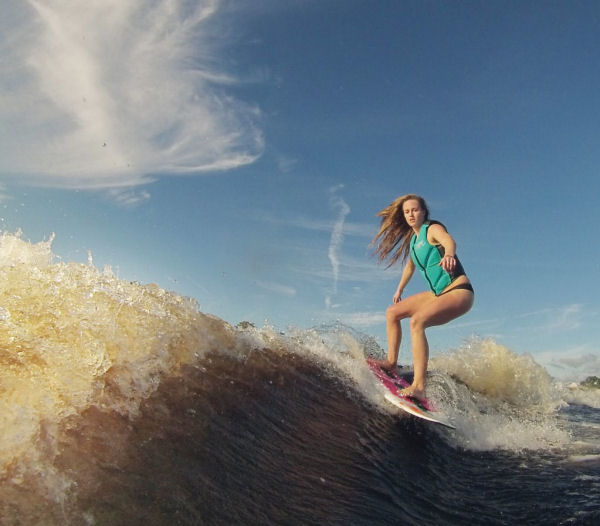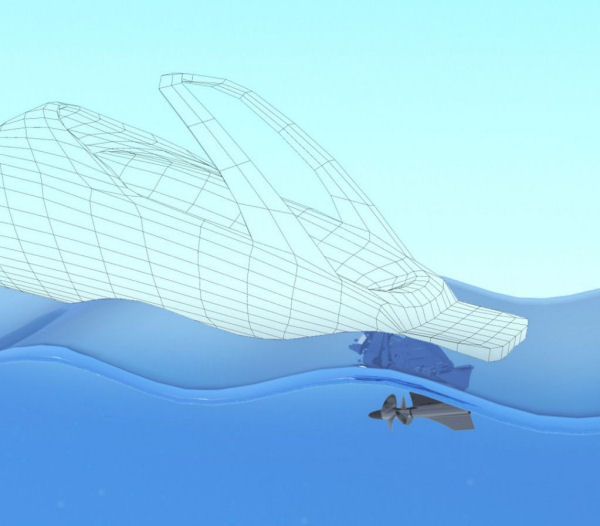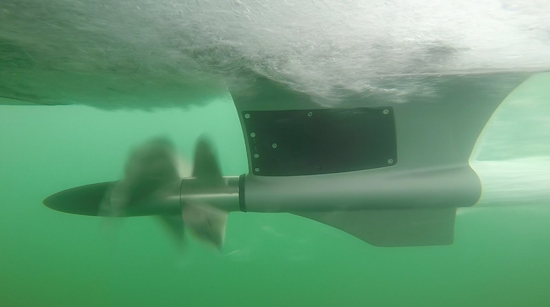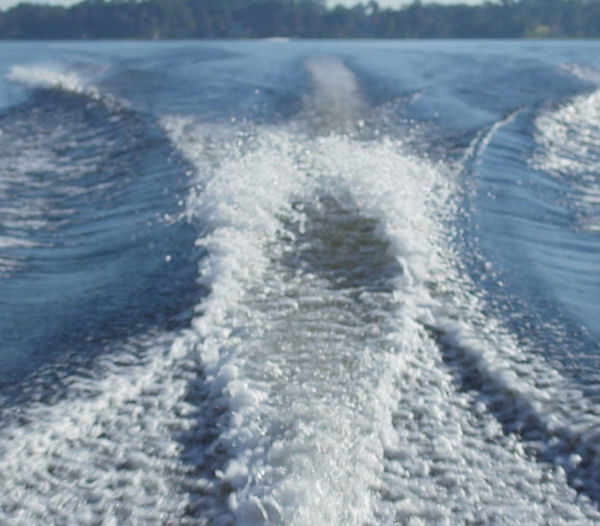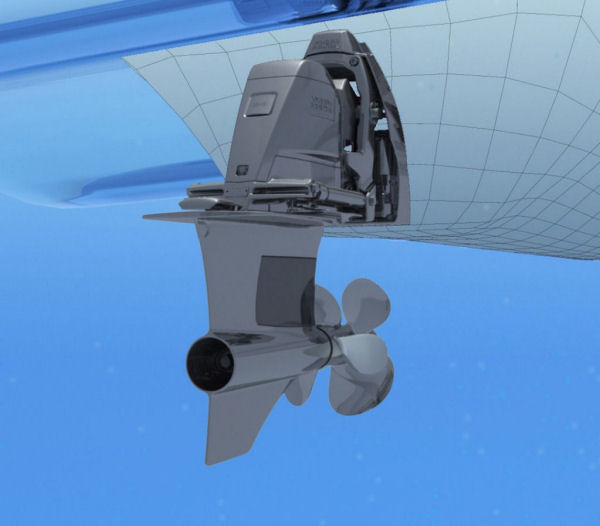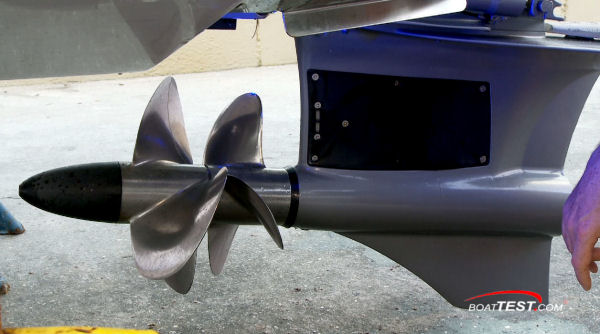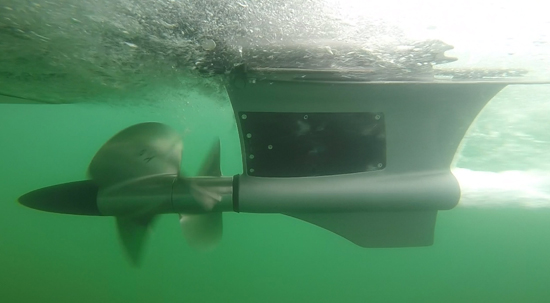Brief Summary
The fastest-growing water sport these days is wakesurfing, a natural evolution of wakeboarding. The critical difference is, of course, that in wake surfing the person on the board riding the wake is not being towed and is relatively close to the stern of the boat, sliding down the wake toward the boat’s transom. That is why, heretofore, virtually all wakesurfing has been done behind inboard-powered boats where the prop is under the boat and not protruding behind the stern where an accident might occur.
This reality has all but shut the door on conventional sterndrive boats for use in the newly-popular sport of wakesurfing – until now. In February 2015 Volvo Penta unveiled its latest engineering masterstroke called the Forward Drive which mixes the concept of the sterndrive with the forward-facing DuoProp configuration of a Volvo Penta IPS. The result is props just below the transom and both under and forward of the lower drive unit. Volvo Penta tells us that this has effectively moved the spinning props 26” forward from where they would have been with a conventional sterndrive, as well as placing the large metal drive unit between the props and potential trouble.
Key Features
Specifications
| Type of Engine | |
|---|---|
| Number of Cylinders | |
| Horse Power | |
| Configuration | |
| Weight | |
| Fuel Type | Gasoline |
| Fuel Delivery | |
| Shaft Length Options | |
| Shift Throttle Control | |
| Displacement | |
| Steering Control | |
| Recommended Fuel | |
| Alternator Output | |
| CARB Rating | |
| Engine Monitoring System |
Captain's Report
Every now and then, we see new technology at a boat show and scratch our heads in wonder. The Volvo Penta Forward Drive (FWD) is such an example. What took so long for this product to be invented? The answer is that the advent of wake surfing in the last few years was the inspiration.
Volvo Penta has long built its business on innovation – for example the sterndrive, the counter-rotating DuoProps, and the Volvo Penta IPS with joystick, among other things. Now with the combination of a couple of proven concepts, Volvo Penta’s engineers have invented yet another innovation to improve the boating experience.
Overview
The forward-facing, dual counter-rotating propellers work in undisturbed water to provide thrust to propel the boat, as opposed to aft-facing props which must work in water disturbed by the lower unit. The power trim is used to adjust the propellers thrust angle which can help to create large wakes or provide a good running attitude for cruising.
The FWD’s tractor-style propulsion leverages technologies from over a decade of development from Volvo Penta’s IPS category. This forward-facing prop configuration has proven its worth in larger cruising boats as well as in commercial maritime applications. Understandably, the FWD’s lower gear case resembles that of an IPS pod drive that has been fixed to a standard sterndrive upper housing.
Larger Props. The exhaust is ducted out of the back of the drive housing and as a result - propellers do not need to be designed to pass exhaust through the hubs. Therefore, more efficient propellers can be utilized resulting in improved speed, acceleration, maneuverability and fuel economy.
Performance
We have recently tested dedicated wake sportboats equipped with the Forward Drive propulsion set-up and found the manufacturer’s claims to be true when it comes to the improved handling. The units seem to react quicker to steering input to provide a more responsive feel at speed and enable a tighter turning radius.
Docking. We also found that it gave our test boat improved maneuverability around the dock and when pulling into slips. This is where the Forward Drive really shines, as conventional inboard powered ski boats provide pilots with a challenge when navigating tight situations.
Wake Formation
The dual propellers of the drive produce less torque steer than a single-prop drive and allow the vessel to track straighter while at cruising speeds. They also create a symmetrical wake so that both port and starboard sides are equally shaped. This means that riders don’t have to favor one side of the wash over the other during tricks or while surfing, though it is important to note that most often, wake side preference is based on whether the rider is left-handed or right-handed.
By vectoring the thrust down, the drive is effectively pulling the stern of the boat down to create the increased displacement needed for large wakes. It also may eliminate the need for added ballast from water bags or tanks for some enthusiasts. In these applications, valuable storage space will be available. Of course, hard-core enthusiasts will gain even more wake shaping power by adding ballast, but the FWD’s capabilities give owners the option.
There is a breakaway coupling inside the housing between the vertical drive shafts to reduce damage should the propellers strike a heavy object. The Forward Drive is available in 1.95:1, 2.14:1, 2.32:1 final drive ratios, and engine/drive packages come equipped with standard power steering for effortless control.
Observations
Inboard-powered boats have been the vessels of choice for the most ardent wake surfers because the boat’s prop is safely tucked away under the boat and because these boats were already designed to sink their sterns for wakeboarding. Now the Forward Drive can give the opportunity to turn every sportboat into a potential wake surfing platform.
Both forward-facing and aft-facing props are vulnerable to striking objects. However, pretty much the same is true of the Volvo Penta IPS with forward-facing props, and this design seems not to have deterred sales.
Finally, there is the obvious safety aspect of the drive. For that reason alone, the new Forward Drive lower unit might well find a broader acceptance than just among wake surfers.
It is important to note that typically, to create a wakesurf boat, additional development is required and cannot be accomplished by simply swapping the drive. The drive is one component of the complete package. The addition of ballast tanks, specialty wake enhancing trim tabs, and a GPS-based speed control system are commonly integrated into the package.
